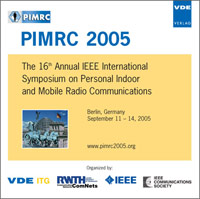On the Code and Soft Capacity of the UMTS FDD Downlink and the Capacity Increase by using a Secondary Scrambling Code
Conference: PIMRC 2005 - 16th Annual IEEE International Symposium on Personal Indoor and Mobile Radio Communications
09/11/2005 - 09/14/2005 at Berlin, Germany
Proceedings: PIMRC 2005
Pages: 5Language: englishTyp: PDF
Personal VDE Members are entitled to a 10% discount on this title
Authors:
Staehle, Dirk (Dept. of Distributed Systems, University of Würzburg, Germany)
Abstract:
The downlink capacity of a UMTS FDD network is limited by the number of available channelization codes (code capacity) and by the available NodeB transmit power (soft capacity). The channelization codes of one sector are taken from an OVSF tree such that the number of codes per spreading factor is equal to the spreading factor itself. In the case that the codes of the OVSF tree are already exploited and the required transmit power is still clearly below its maximum, it is possible to establish another OVSF tree by using a secondary scrambling code. In this paper we develop a Monte Carlo simulation model for comparing the code capacity with the soft capacity of a UMTS network with sectorization, soft and softer handover. Several factors of influence like the orthogonality factor, the user activity, or the codes and power that are reserved for the HSDPA are investigated. Additionally, the capacity increase by using a second OVSF tree with the secondary scrambling code is studied.


